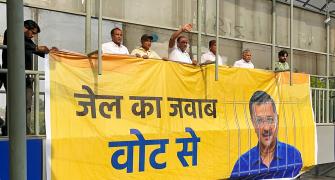The battle for India's retail market is heating up. Consider these signs: as India's economy booms, with 8.7% growth expected this year, Indian retailers are now starting to invade rivals' turf in an effort to build a nationwide network.
So attractive is the prize, that companies from other businesses are jumping in-that's what commodities and telecom player, Mumbai-based Aditya Birla Group, is doing as it prepares to launch a major retail operation in the middle of next year.
But the biggest sign that the subcontinent is gearing up for a shopping revolution came on Nov. 27. That's when Bentonville, Ark.-based Wal-Mart Stores announced its plans to link up with New Delhi-based Bharti Enterprises, India's largest mobile phone company, to start selling by 2007 to the cost-conscious Indian consumer.
Because of continuing restrictions on foreign involvement in retail, the joint venture will focus on logistics, warehousing, and the cash-and-carry wholesale business, at least initially.
'Size is Everything'
Meanwhile, the pressure is on for the Indian players to snap up market share-the more the better. And given the stakes, speed, too, is critical. So local competitors, including new entrants such as Reliance Retail, and longer-established players including Mumbai-based Future Group and Shoppers' Stop-the retail arm of Mumbai-based construction company K Raheja group-are jumping in.
Trent, the retail portion of conglomerate Tata Group, as well as Kolkata-based Spencer's Retail, are sprucing up their product offerings, opening more outlets, and entering into a range of retail formats, from neighborhood stores and hypermarkets, to department stores and even kiosks. It's all part of their quest to become pan-India players. "In today's market size is everything. Wal-Mart isn't something that we should worry about, says Kishore Biyani, CEO of Future Group.
Brave words, but given the size of the potential market, maybe Biyani is right-there may be room for both domestic and foreign. Today, India is the land of shopkeepers, dominated by a staggering 12 million neighborhood, or kirana, stores, ranging in size from 50 sq. ft. to 150 sq. ft.. But the future may well belong to the big-outlet, Western-style retail format, which now only makes up 3% of the total market.
Supersizing Stores
With consolidation continuing, that portion of the market should grow to 10% by 2010, when today's $300 billion Indian retail market will reach $427 billion, predicts New Delhi-based consumer-goods consultancy Technopak Advisors. And by 2015, the total market value should reach $637 billion.
Already, specialty stores are proliferating, selling everything from books to health-care goods and home furnishings to apparel. But it is the large-format supermarket and hypermarket stores that are sucking up the lion's share of investment. Technopak reckons that today's total of 50 hypermarkets-which are superstores that combine a supermarket with a department store-will grow to 1,200 across India by 2011, at which time there will be 3,000 supermarkets, twice as many as there are today.
And that will require $25 billion to be invested in the retail sector over the next five years, as compared with the $2 billion that trickled in over the last decade-35% of that investment is expected to come from the foreign players.
Marking Their Territory
But even before the big foreign money arrives, local players are ramping up operations. Future Group's Biyani says he plans to expand from 160 stores today to 3,300 by 2010, which will require opening a store a day for the next three to four years. "We want to capture consumer spending," says Biyani.
He wants to expand his discount Big Bazaar stores, the Indian version of Wal-Mart, from the current 37 to 100 by December, 2007, before "any international retailer opens its store here," he says.
Or take the 108 stores in the Spencer's Retail chain that includes hypermarkets, supermarkets, and daily convenience stores, all part of RPG Enterprises. After a split last year with its erstwhile partner Dairy Farm International, part of Hong Kong-based Jardine Matheson Holdings, it has also had to part with the well-known Food World brand, a chain of supermarkets that pioneered food retailing in India.
For years, Spencer's Retail was a south Indian brand, but now Vice-Chairman Sanjiv Goenka is aiming to have a national footprint. That will require opening 1,900 stores in three years with a total investment of $450 million. "Give us scale, and sales growth will come," he boasts.
Perhaps the most ambitious is Reliance Retail, which plans to invest $5 billion to build 10 million square feet of retail space over the next four years. With its deep pockets, it plans to set up a range of different store formats, including convenience stores and hypermarkets as well as create a back-end retail-services business.
Real Estate Challenge
Making its retail debut in November, Reliance chose to focus first on selling produce, which accounts for a full 75% of all retail purchases in India, compared with just 25% in the U.S. Today, there are 22 Reliance Fresh 250-sq. ft. neighborhood stores, in Hyderabad in the south and in north India's Jaipur, Rajasthan.
To be sure, the growth of a developed retail market in India won't be easy. And perhaps the biggest challenge facing companies is India 's soaring real estate prices. According to a report earlier this year by JM Morgan Stanley, a Mumbai-based joint venture between Morgan Stanley and JM Financial Group, one of India's top financial-services companies, India's commercial and residential property prices are up 80% to 100% over the last year. "It's simply a demand-supply situation," says Govind Shrikhande, CEO at Shoppers' Stop.
His company's plans call for spending $250 million to expand its current 20 department stores to 50 and its one existing hypermarket-Hypercity in Mumbai-to 18, over the next five years. And Shrikhande predicts that over the next five years the expansion of the Indian retail sector will require an additional 200 million square feet. That won't be easy. Given tight land resources, he expects a shortfall of 20 million to 30 million square feet.
Joining Hands?
That reality has savvy Indian retailers doubling as real estate agents as well. Eight months ago, Reliance Chairman Mukesh Ambani and his friend and colleague Anand Jain set up a $555 million realty fund. And Future Group's Biyani created the Kshitij realty fund in March, 2005, four years after he launched his retail operations. Now not only does he have a stable supply of land for his company's malls, but he also runs a business selling space to his competitors.
The biggest challenge ahead is likely to come from the Wal-Marts, Metros, Carrefours, and Tescos. Competing head-on with these behemoths will be tough, particularly as today's restrictions, including a ban on foreigners operating anything but single-brand outlets, begin to gradually be lifted.
But the future could also bring new opportunities for Indian players who opt to link up with, or even sell to, the big international retailers, something that is already quietly being discussed by some of India's biggest retailers, say retail industry analysts.
Meanwhile, as they race to add capacity, retailers are counting on the fast-growing Indian economy to support their ambitious expansions. "There's room for everybody," says Raghu Pillai, CEO of operations and strategy at Reliance Retail.
Bullish attitudes like that will no doubt continue to fuel the Indian retail revolution.







